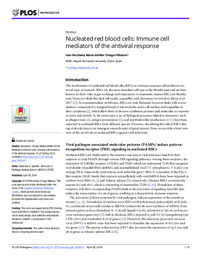Please use this identifier to cite or link to this item:
https://hdl.handle.net/11000/7000
Nucleated red blood cells: Immune cell
mediators of the antiviral response
Title:
Nucleated red blood cells: Immune cell
mediators of the antiviral response |
Authors:
Nombela Díaz, Iván
Ortega-Villaizan Romo, María del Mar |
Issue Date:
2018-04-26 |
URI:
http://hdl.handle.net/11000/7000 |
Abstract:
The involvement of nucleated red blood cells (RBCs) as immune response cell mediators is a novel topic of research. RBCs are the most abundant cell type in the bloodstream and are best known for their roles in gas exchange and respiration. In mammals, mature RBCs are flexible, oval, biconcave disks that lack cell nuclei, organelles, and ribosomes (reviewed in Moras et al. 2017 [1]). In nonmammalian vertebrates, RBCs are oval, flattened, biconvex disks with a cytoskeleton composed of a marginal band of microtubules and a cell nucleus and organelles in their cytoplasm [2], which allow them to de novo synthesize proteins and molecules in response to stress and stimuli. In the recent past, a set of biological processes related to immunity–such as phagocytosis [3], antigen presentation [3], and interleukin-like production [4–7]–have been reported in nucleated RBCs from different species. However, elucidating the role of RBCs during viral infections is an emergent research topic of great interest. Here, we provide a brief overview of the novel role of nucleated RBCs against viral infections
|
Knowledge area:
Bioquímica. Biología molecular. Biofísica |
Type of document:
info:eu-repo/semantics/article |
Access rights:
info:eu-repo/semantics/openAccess |
DOI:
https://doi.org/10.1371/journal.ppat.1006910.g002 |
Appears in Collections:
Instituto de Biología Molecular y Celular
|
 ???jsp.display-item.text9???
???jsp.display-item.text9???

.png)
